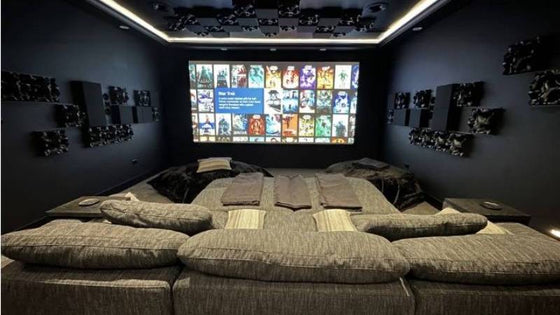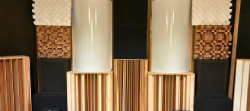Creating a system you love shouldn't be difficult. The Acoustic Frontiers blog is here to help.

A high end stereo system is something magical. Properly done, a high end audio system will transform how you listen to music and give you immense satisfaction for years to come.
A high end stereo system is more than the sum of its parts. Stereo systems, unlike home theaters, have only a few pieces. Each one makes a substantial impact on the experience.
The key components of a high end audio system are, in order of importance:
Yes, you read that right, something that you don’t buy (the room) has a huge effect on sound quality. To learn why, read on.
Speakers turn electrical energy into sound energy.
There are two main types of speakers:

Speakers overlay their own signature on the music much more than sources or amplifiers. Even the best speakers overlay a little coloration, changing how you perceive the sound. That is because no speaker has a flat frequency response. Many high end stereo speakers are actually designed to have a non-flat response!
There are a very large number of speakers on the market and most are in our opinion just ‘ok’. Maybe it is because the barriers to entry for a new manufacturer are lower in the speaker category than in the source or amplifier category. You can buy drivers off the shelf from major original equipment manufacturers like Seas, get a computer program to design a crossover for you and then build the box in your shed. The results from these types of endeavors are seldom great.
The best speaker manufacturers will design all their own drive units in house and will perform extensive measurements as part of the design and QA process.
You should start the process of assembling a high end stereo system by choosing speakers.
The room in which you listen to music is critical to your experience and enjoyment.
Good sound does not just mean expensive equipment. The type of room you put your system in and where you put your listening chair and speakers makes a huge difference.

It is important to understand that when you listen at 9 or 10ft to a high end stereo system what you are hearing is about 1/3rd direct sound (sound that travels directly from the speaker to your ears) and 2/3rd reflected sound (sound that bounces off one or many surfaces in your room before reaching your ear). If you think about it like this, then you’ll understand why the room has such a large effect on what you hear.
Rooms are even less linear than speakers. A typical room will introduce huge peaks and dips in the bass, audible as boomy bass that lacks articulation and definition. These bass issues are caused by “room modes”. Rooms that sound ‘echoey’ when you talk will likely have poor imaging and soundstaging caused by your brain getting confused by all the reflected sounds.
Many speakers are designed to be placed away from walls. They won’t sound their best if they are placed 1 or 2ft from the wall behind. Where you put the speakers, and your chair, also affects the pattern of the peaks and dips in the bass.
A key part of dialing in your high end stereo system is therefore reducing the issues introduced by the room through things like acoustic treatment (panels that help absorb and diffuse sound) and careful speaker set-up.
These days the main sources used in high end stereo systems are:
Less common are radio (either AM, FM or that streamed over the internet) and the niche optical media such as SACD and DVD-Audio.

You can’t just connect a source straight to speakers. In the middle you need an amplifier.
There are two different types of amplifiers: Pre-amplifiers and power amplifiers.
Generally at the high end manufacturers make ‘separates’ . This phrase refers to having a pre-amplifier in one chassis and a power amplifier in another. If the pre-amp and power amp stages are combined in one chassis then you have an integrated amplifier.
In the “old days” pre-amps used to be simple things that could only accept analog signal. These days there are many that can accept both analog and digital inputs. The pre-amp you need depends on what sources you have.

With power amplifiers first and foremost you need something that has enough power (measured in Watts) to drive your speakers to the loudness level you want (Sound Pressure Level, or SPL). Some speakers are easier to drive than others, and the physical size of the speaker often has little relationship with how much power they need. This specification is called sensitivity.
There is nothing wrong with a low or high sensitivity speaker, you just need to select a power amplifier accordingly.
You need to plug your equipment into the electrical outlet, and you should not just plug it straight in. At a minimum you should have a good surge protector. And no we don’t mean the generic $10 surge protection strips. We mean a device incorporating effective and long lasting series mode surge protection technology.

Cables are required to connect source to amplifier and amplifier to speaker. It’s easy to spend a ton of money on audiophile cables. In our experience the differences between cables are small, and it is much more important to invest your dollars in the speakers and room for the reasons we outlined above.
Finally you’ll need somewhere to put your sources and amplifier. Entertainment cabinets, widely available from many manufacturers work fine. Again in our experience speakers and rooms are the critical things.
This media room was intentionally designed to feel like part of the home—not a separate, tech-heavy space. Through careful acoustic planning, equipment integration, and final calibration, we achieved a room that is both beautiful to live in and immersive to experience.
"No other subwoofer system I’ve owned even comes close to what this room delivers. Reaching out to Acoustic Frontiers was one of the best decisions I’ve made—I highly recommend working with them if you want to get the most out of your theater."

Nyal Mellor, Founder, Acoustic Frontiers



Nyal Mellor
Author